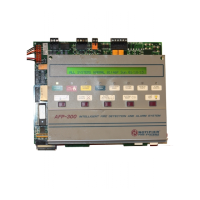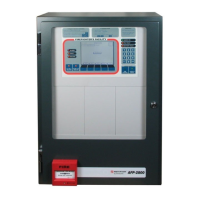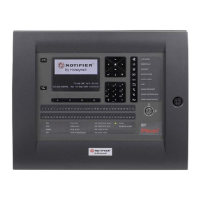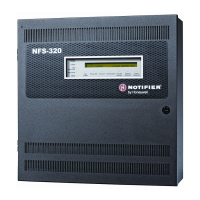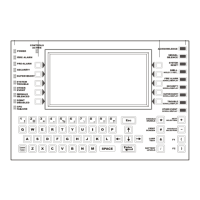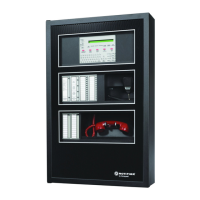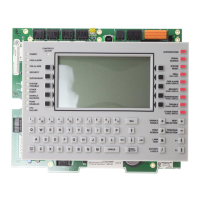19 AFP-3030 Operations Manual — P/N DOC-01-039:A 26/11/2015
Operation of the Control Panel System or Point Fault Event
• Sends a “System Normal” message to the panel display, History buffer, installed printers and
annunciators
• Restores faults automatically - even if faults are not acknowledged
2.3.3 Fault Types
There are a variety of point or system fault types that may appear in the fault message. The tables
below give lists of the faults and indications of their cause.
Point (Device) Faults
A message from the “Fault Type” column in Table 2.1, “Point (Device) Faults,” on page 19 will
appear in the upper right corner of the panel display when a point (device) fault occurs. Use this
table to help determine what the fault is.
POINT FAULTS
FAULT TYPE FAULT DESCRIPTION ACTION
AC FAILURE The main or auxiliary power supply has lost AC power. Determine whether there is an AC power loss or whether the
power supply and wiring is correct.
ALIGNMENT MODE A beam detector is in configuration mode. No action is necessary, as the fault will clear when the
configuration is complete. However, the detector will not detect
a fire while this fault exists.
AMPLIFIER LIMIT The DAL device is overloaded, Remove outputs to lower the load on the speaker circuits.
Press reset when done.
AMPLIFIER
SUPERVISION
The amplifier’s internal supervision on the DAL device is
not working,
Call Technical Services.
ANALOG OUTPUT x
FAULT
A fault has occurred on the DVC-AO analog output x (1-
4). The analog output is configured for Style 7, but no
audio signal is returned.
Investigate and fix.
ASPIRATOR FAULT There is a problem with the FAAST detector. Replace the FAAST detector.
AUDIO LIBRARY
CORRUPT
The Audio Library is corrupt. The database must be re-downloaded, or all programming
must be cleared and re-entered. if the fault does not clear, call
Technical Services.
AUDIO LIBRARY
INCOMPATIBLE
The Audio Library is not compatible with the
programming database.
Download the correct application or version.
AUTOLEARN FAILURE The Autolearn function has failed to complete. Refer to the associated detector’s product guide for additional
information.
AUXIN FAULT This fault will be generated when the auxiliary input on
the DVC is supervised (as determined by VeriFire Tools
programming) and insufficient signal is detected on the
input.
Check the DVC wiring and source.
BATTERY HIGH The power supply’s battery charge is too high. Check the batteries for problems. Replace batteries if
necessary.
BATTERY LOW The power supply’s battery charge is low, or the RFX
device’s battery charge is low.
Check the batteries for problems. Replace batteries if
necessary.
BEAM BLOCKED Something has come between the detector’s beam and
its reflector.
Investigate and clear the blockage.
BRAND MISMATCH The brand of this SLC device is incompatible with this
FACP system.
Replace with compatible device.
BUZZER OFF The DVC’s piezo is disabled. Re-enable the piezo at switch 5.
CHARGER FAULT
*
The power supply’s battery charger is not working
properly.
Correct the fault.
CO 6 MONTHS The CO (carbon monoxide) detection element on a
detector has six months left to expiration.
Replace the detector.
CO EXPIRED The CO (carbon monoxide) detection element on a
detector has expired.
Replace the detector.
CO FAULT The CO element on a detector is not working properly.
This fault is generated for FlashScan mode only.
Replace the detector.
COMM LOSS Communication has been lost between the FMM-4-20
module and its 4-20 mA sensor.
Check connections between the FMM-4-20 module and the
4-20 mA sensor.
CONFIGURATION
FAULT
A problem has occurred after the configuration was sent
from the PipeIQ to the FAAST detector.
Re-download the configuration.
DAL DOWNLOADING The DVC is currently downloading to a DAL device. n/a
DAL DUAL ADDRESS
CONFLICT
More than one DAL device has the same address. Re-address DAL device(s).
DAL NO ANSWER The DAL device is not communicating. The DAL device address will display at the panel or network
annunciator. Investigate and fix.
Table 2.1 Point (Device) Faults (1 of 3)

